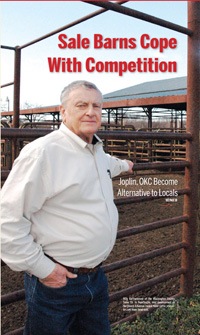Sale Barns Cope with Competition
by March 10, 2008 12:00 am 204 views

Scan the sale barn numbers for Fayetteville, Springdale and Fort Smith over the last few years and it’s easy to wonder: Where’s the beef?
Turns out it’s been heading to Joplin, Mo., and Oklahoma City.
Cattle sales in Fayetteville during 2007 at the Washington County Sales Co. were down nearly 50 percent from 2003 and the Farmer’s Livestock Auction in Springdale saw a decline of 39.7 percent in the same period.
Fort Smith felt a smaller dip of 14.7 percent.
Across Arkansas, 66,775 head of cattle have sold through Feb. 29, compared to 76,825 through the same period in 2007, a decline of 13 percent.
“The cow numbers haven’t really changed,” said Tom Troxel, beef specialist with the University of Arkansas Cooperative Extension Service in Little Rock.
“What’s happening is the larger producers are getting larger, the smaller producers are getting smaller and cattle are being marketed in other ways besides local sale barns.”
Troxel said many producers in Northwest Arkansas have taken to selling their herds at sale barns in Joplin and Oklahoma City.
They can get a better price because of more competition and more buyers are inclined to make purchases when they can buy cattle in groups rather than individually.
“If you’re buying 50 calves at a time, you can get a discount,” Troxel said.
Billy Bartholomew, who has worked at the Fayetteville sale barn for 40 years, said the last five years has seen “quite a drop” for a number of reasons.
Not the least of those is the rapid growth of Northwest Arkansas.
Thousands of acres of former pasture and farmland have been transformed into commercial developments or residential subdivisions.
“There’s not as many producers out there, bottom line,” Bartholomew said. “When older people get out, young people don’t get back in and the property sells. That has been a big factor.”
Fewer producers, and the remaining ones around heading for better prices at other markets, has been a major blow to local sale barns which take a commission off each head.
Combine fewer head sold with falling prices and those sale barn commissions take a double whammy.
Across the country, beef demand dropped 3.2 percent in 2005 and 6.6 percent in 2006 before rising around 1 percent for 2007.
But demand forecasts for 2008 are tough to peg after beef’s gains in the first three quarters of 2007 went flat in the fourth.
Troxel said consumers bucked higher beef prices for much of 2007, but with various ongoing financial crunches and daily pains at the gas pump, demand could be curbed yet again.
“Beef was the highest price of all-time at the case last year,” Troxel said. “But people were still buying. The question is now, with all that’s happening, will people still pay that much for beef?”
Producers have been socked with those rising fuel costs as well, not to mention spikes in feed prices brought on by increasing prices for corn and grain.
“The price of feed has jumped,” Bartholomew said. “It’s $75 to $100 a ton more for feed over the last year.”
“It’s just eating into profits and everything has been in the red for three or four months now. People are just trying to stay in business.”
